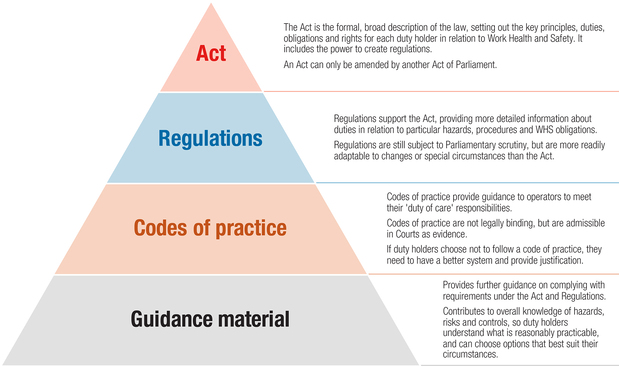On 31 March 2022, the Work Health and Safety (WHS) laws replaced the health and safety elements of the Mines Safety and Inspection laws. For information visit www.demirs.wa.gov.au/whs
All health and safety notifications, forms and guidance for mining and petroleum has moved to the WorkSafe website
Find out how the legislative system works in the Western Australian Parliament.
How is legislation made in Western Australia?
The Parliament of Western Australia makes laws that apply in WA. An Act of Parliament starts as a Bill, which is debated in and passed by each House of Parliament. The contents of the Bill can change as debate progresses.
Once a Bill has been passed by both Houses of Parliament, it is assented to by the Governor of Western Australia on the advice of the Executive Council. The Bill is “enacted”, and becomes an Act, upon assent. Some Acts become part of the law as soon as they are assented to, and some require a further step of “proclamation” before they become laws.
What are Acts and regulations?
Acts are legislation passed by Parliament. They can be changed by further Acts of Parliament.
Regulations are made under Acts, and typically provide further detail about how the overarching requirements of the relevant Act will apply. Regulations do not have to be passed by Parliament in the same way as Acts.
Both Acts and regulations can specify things that are a breach of the law, and the penalties that apply when a breach is committed.
An Act dictates what must be done while a regulation describes how to do it.
What legislation is the department responsible for?
For the full list, see Legislation administered by the department.
How are codes of practice and other guidance used?
Codes of practice are supplementary to requirements under the Acts and regulations. They are intended to supplement such requirements in a uniform way and, as far as possible, clarify any ambiguity or uncertainty in the Acts and regulations. Codes of practice also set out requirements and recommendations on aspects that are not explicitly covered by regulations.
These requirements and recommendations are based on industry best practice and are developed in consultation with industry, unions and the public. They are usually consistent with Australian and international standards, international guides and codes, and advice from regulatory authorities.
Although codes of practice do not have the scope for fines or other prosecution actions, they may contain specific applications of the Act or regulations.
Guidelines, guidance notes, the answers to frequently asked question, and other information are also published by the department to provide information relevant to a specific issue or subject. Many are developed with input from industry, unions and other members of the public. While they are not legally binding, such guidance is created to support application of the relevant Acts and regulations and promote leading practice.
What is the basis for codes of practice?
A code of practice is a guide to achieving the standards of occupational safety and health required under legislation. It applies to anyone who has a duty in the circumstances described in the code.
A code of practice will help those with the functions and responsibilities for managing risk in the circumstances described in the code. The code may also be used by workers and safety and health representatives who need to understand the hazards and risks associated in the circumstances described in the code.
In most cases, following a code of practice would achieve compliance with the duties in the legislation in relation to the subject matter of the code. However, like regulations, codes of practice deal with particular issues and do not cover all hazards or risks that may arise. Duty holders need to consider all risks associated with work, not only those for which regulations and codes of practice exist.
Codes of practice are admissible in court proceedings. Courts may regard a code of practice as evidence of what is known about a hazard, risk or control and may rely on the code in determining what is reasonably practicable in the circumstances to which the code relates. However, compliance with the legislation may be achieved by following another method, such as a technical or an industry standard, if it provides an equivalent or higher standard of work health and safety than the code.
An authorised officer may refer to an approved code of practice when issuing a notice.
What are the types of codes of practice?
Codes of practice are produced to provide safety recommendations to assist people in meeting their obligations under relevant Act and regulations. These codes (and standards) are approved and gazetted by the Minister for Mines and Petroleum (under the relevant Act) and may be used as a defence in law.
There are some approved codes and standards for the dangerous goods safety legislation that are prescriptive either in part or in their entirety and are referenced in the relevant regulations either directly or indirectly. These prescriptive codes and standards must be followed. For all other approved codes, compliance is not mandatory.
What is the basis for guidelines and other guidance?
A guideline is an explanatory document that provides more information on the requirements of legislation, details good practice, and may explain means of compliance with standards prescribed in the legislation, such as safety or security advice.
Compliance with a guideline is not mandatory but it could have legal standing if it were demonstrated that the practices covered in the guideline are the industry norm.
Guides and procedures are ‘mud maps’ to regulatory information and may include licensing information and definitions.
Guidance notes contain regulatory information and requirements (but not detailed licensing information).
Contributing to the development of guidance
Codes of practice and guidelines go out for public comment as part of the consultation process.
Invitations seeking public input are publicised online and through weekly news alerts. Refer to Subscribing to Resources Safety’s weekly news alerts for information on how to sign up.

